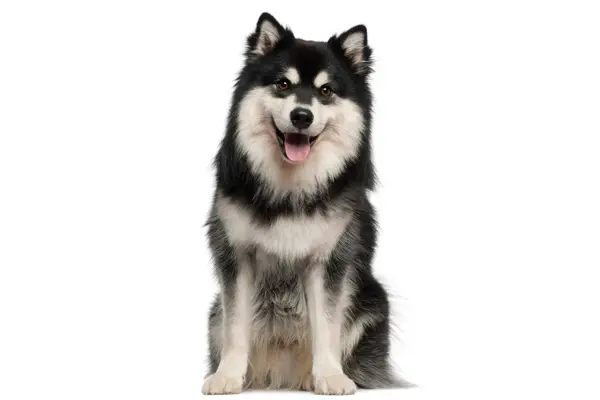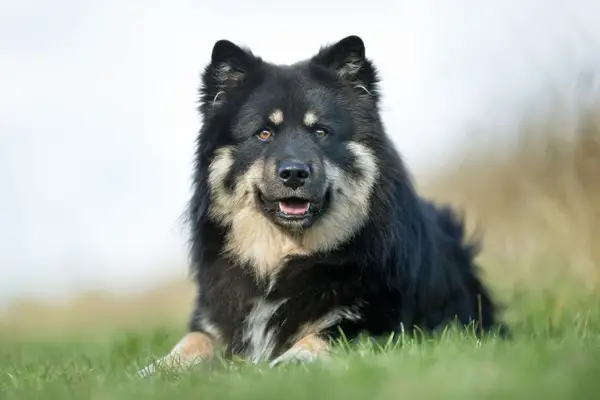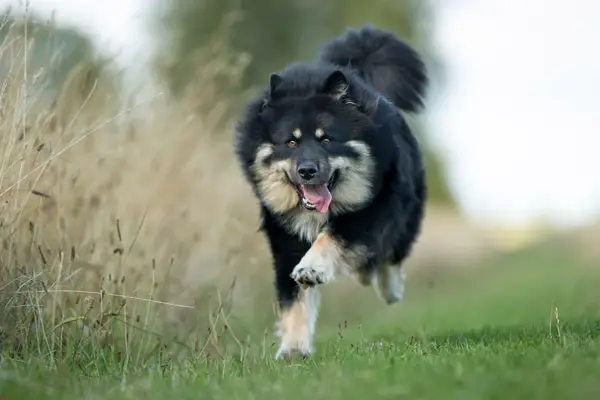Finnish Lapphunds are medium-sized dogs that usually stand at a height of 21 inches. These dogs are Nordic dogs that usually feature luscious coats, coated tails that curled to the back, and spitz-like faces. Despite their muscular build, the Finnish Lapphund is known to be quick and agile.
Finnish Lapphunds are smart, friendly, and alert dogs that make excellent companions and watchdogs. They are the best fit for families who are also active. You should also make sure that they are not left alone for long periods, or they’ll surely get unhappy.

Finnish Lapphund Statistics
| Dog Breed Group | Herding |
| Breed Size | Medium |
| Height | 18-21 inches (male); 16-19 inches (female) |
| Weight | 33-53 pounds |
| Lifespan | 12-15 years |
Finnish Lapphund Ratings
| Energy level | |
| Exercise needs | |
| Requires attention | |
| Playfulness | |
| Trainability | |
| Shedding | |
| Grooming | |
| Friendly with family | |
| Friendly with kids | |
| Friendly with strangers | |
| Friendly with other dogs | |
| Prey Drive |
Finnish Lapphund History
Finnish Lapphunds are very famous dogs in the Nordic countries despite being rare outside their homeland. As their name implies, these dogs originated from the Lapland – an area in the northern Arctic region that spreads through Norway, Sweden, Finland, and Northwestern Russia.
The Finnish Lapphund is said to be kept by the Sami, semi-nomadic people that occupied the area. The job of these dogs was mainly to herd reindeer. However, when snowmobiles were invented, the dogs no longer had any job to do.
So, from herding, they went into homes and became excellent family companions. Around the 1940s, a breed standard was written, which was immediately accepted by the Finnish Kennel Club in 1945.
They were originally called Lapponian Shepherd Dogs, and there were two varieties. But in the year 1967, the two varieties were declared separated breeds, where the long-haired was named Finnish Lapphunds.
The importation of the breed also started in the US. However, it wasn’t until 1987 that the American Kennel Club finally recognized the breed. Now, they rank 161st as the most popular dogs in the US.
They are still very uncommon for most countries but are definitely favorites in their homeland.

Finnish Lapphund Temperament
Finnish Lapphunds are friendly, alert, and agile dogs. As they were required to herd reindeers, they have to be quick and smart to control these animals.
Even today, Finnish Lapphunds have those traits despite being more known as pets. They have strong tendencies to bark, which may not be ideal for those living in apartments.
They are naturally submissive to the owners though they have independent tendencies. They are also usually calm and gentle, even with children and the elderly.
Finnish Lapphunds are naturally aloof to strangers, but they should never be shy or aggressive. These dogs can also live well with other pets, but you must keep close supervision if you have smaller animals as they have tendencies to chase them.
It’s essential to socialize them at an early age, so they become accustomed to meeting new people or animals. This way, they would know the best way to react. Socialization also makes these dogs more well-rounded and more comfortable to live with.
Training should come at an early age, too, and the best way to do it is in the form of positive reinforcements. Keep everything entertaining for them and bring lots of patience as they are not the most obedient dogs.
Care Requirements
- Nutrition: Finnish Lapphunds should do well on any diet type, given that it’s of high-quality and well-balanced. You should watch the number of calories you’re feeding him in a day, so they don’t get overweight. Regardless if you’re feeding them home-cooked meals or dog food, always buy the high-quality ones. For dog foods, always check the label and make sure that they don’t contain fillers, additives, and by-products that have low nutritional value. Take note of any allergies that your dog may have, and be sure to stay away from those ingredients. You can also ask your vet for some guidance on proper feeding requirements that would be specific to what your dog needs.
- Grooming: Finnish Lapphunds are covered with double coats that shed seasonally. It’s essential to give it weekly brushing to remove dirt or loose hair. During the shedding season, you might need to brush the coat daily to keep shedding to a minimum. Baths can be given occasionally as these dogs don’t really have a doggie odor. However, pay close attention to their ears and make sure to clean them regularly. The nails should be trimmed once every two weeks, too, so it doesn’t become too long.
- Exercise: Finnish Lapphunds have very moderate exercise requirements. They are known to be calm dogs so long daily walks should suffice for this breed. Give them play sessions too, which can last for 30 mins. If you have other pets, they can be great playmates for your Finnish Lapphunds. You can provide them toys, too, so they can entertain themselves. If you’d like to go the extra mile, let them participate in herding trials and other canine sports to showcase his agility, obedience, rally, and tracking skills.
- Health: Finnish Lapphunds are generally healthy dogs. There’s really not much health conditions you’d need to worry about other than progressive retinal atrophy, hip dysplasia, and elbow dysplasia. You can let him get some screening tests to detect these diseases early. It’s also best to meet at least one of your dog’s parents to be aware of possible hereditary diseases they might acquire. It’s crucial to monitor your dog’s behavior continuously, and if you see any changes, take him immediately to the vet.
- Lifespan: The life expectancy of Finnish Lapphunds is 12-15 years.

Fun Facts About Finnish Lapphunds
- Finnish Lapphunds are believed to have originated from Lapland, a place covering parts of Finland, Sweden, and Russia.
- They are believed to be an ancient dog breed whose history can be traced back to 7000 BC.
- They were originally called Lapponian Shepherd Dogs.
- They were originally used to herd reindeers.
- They are among the most vocal dogs around.
- They were recognized by the American Kennel Club in 1987.
Check Out Other Herding Dog Breeds:
Australian Cattle Dog, Australian Shepherd, Bearded Collies, Beaucerons, Belgian Malinois, Belgian Sheepdog, Belgian Tervuren, Bergamasco Sheepdog, Berger Picards, Border Collie, Bouviers des Flandres, Briards, Canaan Dog, Cardigan Welsh Corgis, Collie, Entlebucher Mountain Dogs, German Shepard, Miniature American Shepherd, Norwegian Buhunds, Old English Sheepdog, Pembroke Welsh Corgi, Polish Lowland Sheepdogs, Puli, Pumi, Pyrenean Shepherd, Shetland Sheepdog, Spanish Water Dog, Swedish Vallhunds
